In the aftermath of World War II, Argentina found itself in a unique and advantageous position. While the major powers of Europe lay in ruins, Argentina had accumulated significant wealth as a neutral agricultural exporter during the conflict. With substantial foreign currency reserves and agricultural surpluses, the country was poised for industrial development under President Juan Domingo Perón’s ambitious economic plans. The global political landscape was rapidly shifting into the Cold War era, with the United States and Soviet Union engaged in an escalating technological race. In this climate, Perón recognized the strategic importance of developing an independent aeronautical industry. His government actively recruited displaced European scientists and engineers, particularly from defeated Germany, offering them opportunities that were unavailable in their homeland due to post-war restrictions on military and aviation development. This convergence of economic capacity, political will, and available technical expertise created a brief but remarkable window of opportunity for Argentina to leap to the forefront of aviation design. The Fábrica Militar de Aviones (FMA) in Córdoba became the epicenter of this ambition, where revolutionary designs like the IAe-38 “Naranjero” would challenge conventional aviation thinking and demonstrate Argentina’s technological aspirations on the world stage.
The Flying Wing Concept
By the 1930s, aeronautical engineers understood that aircraft fuselages created significant induced drag, requiring more power for takeoff and flight, and consequently increasing fuel consumption. The concept of a tailless, fuselage-less “flying wing” design promised theoretical advantages, but presented formidable stability challenges.
In the United States, Jack Northrop developed two flying wing projects: the YB-35 (with piston engines in a “pusher” arrangement) and the YB-49 (with jet engines). These achieved limited success, similar to earlier German projects developed under wartime secrecy.
Reimar Horten: The Flying Wing Pioneer
In Germany, a young designer named Reimar Horten was pushing the boundaries of aviation with revolutionary flying wing designs. Born in Bonn on March 12, 1915, Horten and his brother began designing aircraft in 1931, starting with their first flying wing, the HO I. By 1932, they had achieved powered flight with the HO II, equipped with an 80 HP Hirt HM 602 engine.
During the war, in 1939, the brothers designed a flying wing “glider” with a distinctive feature—the pilot was positioned prone, a configuration later employed in the Argentine IAe-37.
When World War II ended, Horten’s work on the Horten HO VIII flying wing was interrupted. Walter Horten, the elder brother, moved to the United States in 1948, while Reimar joined Argentina’s Military Aircraft Factory (Fábrica Militar de Aviones or FMA) in Córdoba.
In Argentina, Reimar Horten continued designing remarkable aircraft, including the IAe-37 delta wing (sometimes incorrectly called “Pulqui III”), capable of Mach 2 speeds—extraordinarily advanced for the 1950s. Horten’s influence extended to many Argentine aircraft projects, including the IA-58 Pucará, for which he built the wooden mock-up.
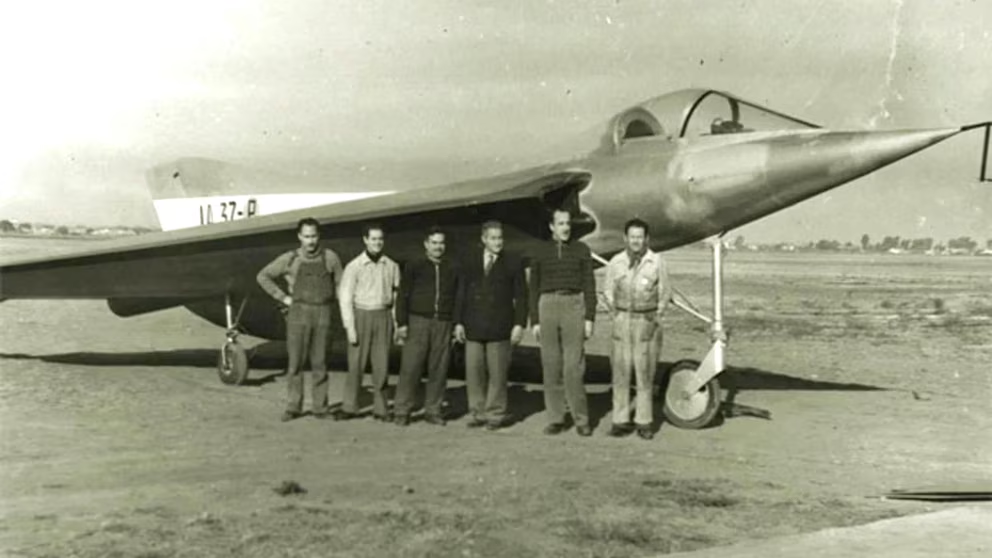
Horten lived in Villa General Belgrano, Córdoba, until his death on August 21, 1993. A monument honoring this engineering giant stands in the city today. His contributions to aviation were widely recognized, including by the Royal Aeronautical Society, which awarded him the prestigious British Gold Medal for his pioneering work on tailless flying wing aircraft.
Argentina’s Flying Wings
Under Horten’s direction, several flying wing designs were developed at FMA:
IAe-34 “Clen Antu” (Sun Ray)
First flown in June 1949, this was the first flying wing built at the Instituto Aerotécnico. It featured conventional flight controls including a directional control extending from the rear seat and differential ailerons coordinated with the rudder. A single-seat version, the IAe-34M, was also produced. With its high glide ratio and low drag, this aircraft allowed Horten to validate his theories.
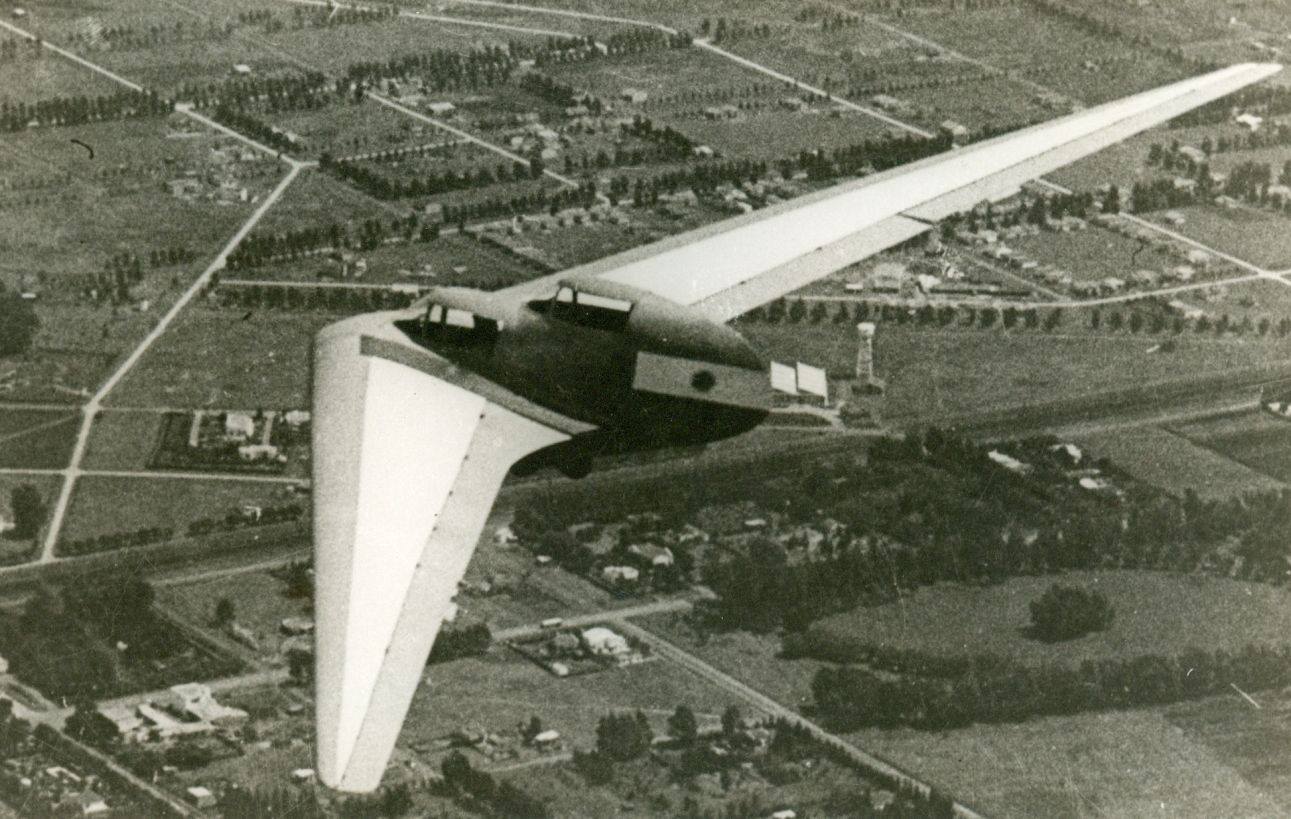
IAe-41 “Urubú” (Vulture)
Based on Horten’s HO XV project, this glider first flew in 1953. On October 30, 1953, pilot Heinz Scheidhauer used this aircraft to cross the Andes from Bariloche, Argentina to Ensenada, Chile—a 3.5-hour flight that confirmed the validity of the pure wing configuration. Later modifications to this aircraft, including winglets near the leading edge that functioned as rudders, would influence the “Naranjero” design.
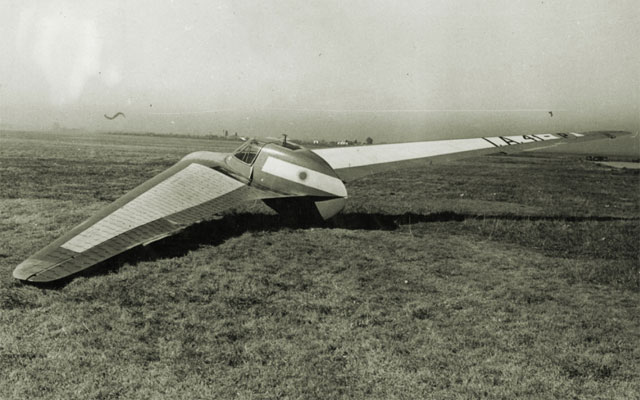
IAe-38 “Naranjero” (Orange Carrier)
Though designated before the “Urubú,” the “Naranjero” flew later. This unique cargo aircraft featured a hybrid design—technically a flying wing, but with a large, angular cargo cabin suspended beneath it.
The IAe-38 “Naranjero”: Argentina’s Cargo Wing
The IAe-38 had an unusual origin. During a meeting between Air Minister General Ojeda and Reimar Horten, Ojeda explained his desire to transport oranges from his home region to Buenos Aires, where Argentina’s best port facilities were located. With poor road conditions and no rail connection, Ojeda initially asked if Horten could design a glider that could be towed by an AVRO Lincoln bomber.
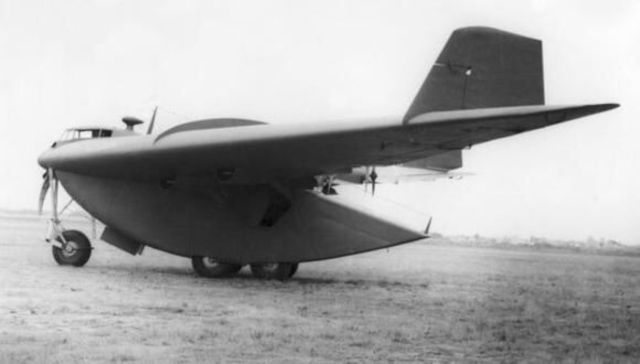
Horten went beyond this request, designing a self-powered flying wing cargo aircraft—the “Naranjero” (Orange Carrier). This aircraft was intended to address a real need in Argentina’s transportation infrastructure by providing economical transport for perishable goods from remote areas to major cities.
Technical Specifications
- Wingspan: 32 meters
- Length: 13.50 meters
- Height: 4.60 meters
- Wing surface: 133 square meters
- Empty weight: 8,500 kg
- Payload: 7,500 kg
- Maximum takeoff weight: 16,000 kg
- Wing loading: 120 kg/m²
- Power-weight ratio: 17.77 kg/HP
- Maximum speed: 252 km/h (with IAe-16 engines), potentially 320 km/h with IAe-19 engines
- Cruising speed: 215 km/h
- Landing speed: 140 km/h
- Range: 1,250 km (with IAe-16 engines), potentially 1,600 km with IAe-19 engines
Design Features
The Naranjero was a high-wing monoplane with a negative wing sweep of 36.5°. It had no tail structure, instead using winglets near the leading edge for directional control—a design proven on the Urubú. The pilot’s cockpit, with tandem seating, was positioned above the wing near the 23-cubic-meter cargo compartment. The cargo door was designed like a “crocodile’s mouth,” doubling as an access ramp.
The aircraft featured a sophisticated propulsion system. The four engines were mounted inside the wing, near the center of the chord, and powered propellers located at the trailing edge through a long transmission system, achieving a “pusher” effect. Engine cooling was achieved through a turbine-type fan coupled to the transmission axis before each motor.
The landing gear system was equally innovative, featuring five wheels. The front wheel was retractable with oleopneumatic shock absorbers and hydraulic actioning, while the main landing gear consisted of two tandem wheels on each side of the fuselaje mounted on a mobile frame with shock absorbers. A compressed air system allowed the pilot to adjust the center of gravity according to the cargo being transported, further demonstrating the advanced thinking behind the design.
The aircraft employed monocoque aluminum construction—another advanced feature for its time. Only one prototype was built, without a separate airframe for static testing. This “testing on the go” approach was common at FMA during this period, having been applied to earlier projects including the IAe-27 Pulqui I.
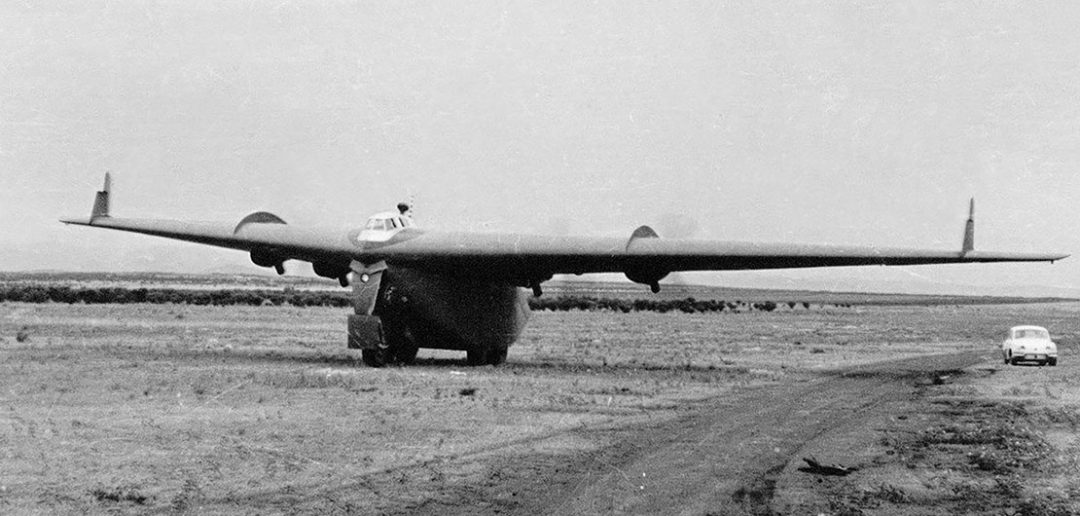
Development Timeline
Construction began in 1953 but wasn’t completed until 1959. The first flight, piloted by Rogelio Balado (FMA’s first formally trained test pilot), didn’t occur until December 10, 1960—at least a decade later than would have been optimal for such an innovative design.
Engine cooling problems, related to the “pusher” configuration, caused further delays. Only four test flights were conducted before the project was abandoned due to “disappointing performance.” However, it’s important to note that these performance issues were largely attributable to political factors rather than inherent design flaws.
The Engine Challenge
The Naranjero was designed to use four IAe-19 “El Indio” engines, each producing 750 HP. However, these engines were prioritized for the more conventional IAe-35 “Huanquero” (initially called “Justicialista del Aire”).
Instead, the Naranjero was equipped with four IAe-16 “El Gaucho” engines, each producing only 450 HP and driving two-bladed, fixed-pitch wooden propellers. This represented a total deficit of 1,200 HP compared to the original design, significantly hampering performance.
The IAe-16 “El Gaucho” itself has an interesting history. Developed during World War II when import restrictions made obtaining the Wright R-975-E3 “Whirlwind” engine difficult, it was essentially a locally produced version of the Wright engine. Despite performing comparably to its American counterpart, the engine gained an undeservedly poor reputation and was often replaced by the less efficient Armstrong Siddeley Cheetah XXV.
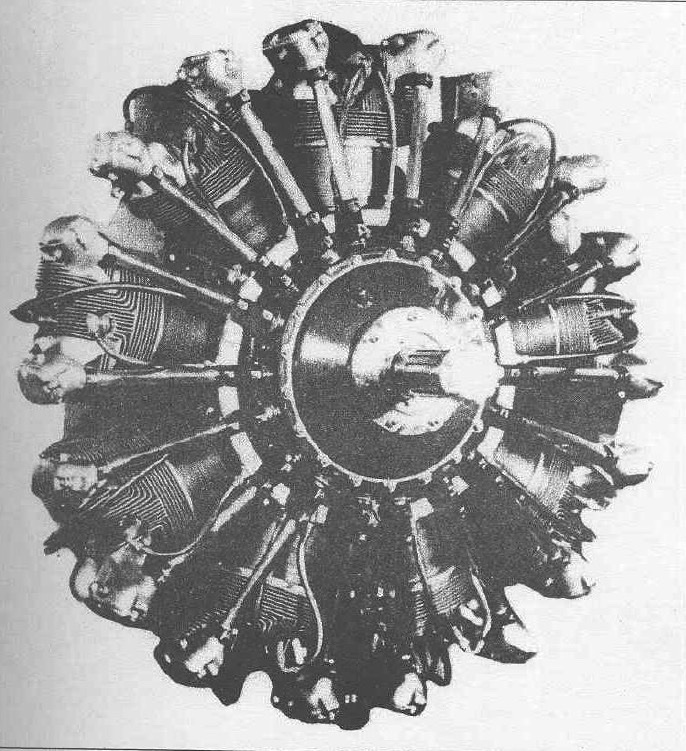
Political Factors and Legacy
The IAe-38 “Naranjero” represents both the ambition and the limitations of Argentina’s golden age of aviation. The project, like many others at FMA, was severely impacted by the 1955 coup that overthrew Perón’s government. The new authorities, hostile to projects associated with the previous administration, withdrew support from many innovative designs regardless of their technical merit.
With greater official support and the proper engines, this revolutionary design might have achieved remarkable results. Instead, it became a fascinating but ultimately unrealized chapter in aviation history—a victim of political animosity rather than technical failure.
It’s worth noting that concepts pioneered in the Naranjero and other Horten designs would only be successfully implemented decades later. The B-2 Spirit stealth bomber, which first flew in 1989, employs many of the principles Horten was exploring in the 1950s, but required modern fly-by-wire systems and computer control to overcome the stability challenges.
As of this writing, the fate of the sole prototype remains unknown. It was reportedly last seen in the late 1960s, after which all traces were lost.
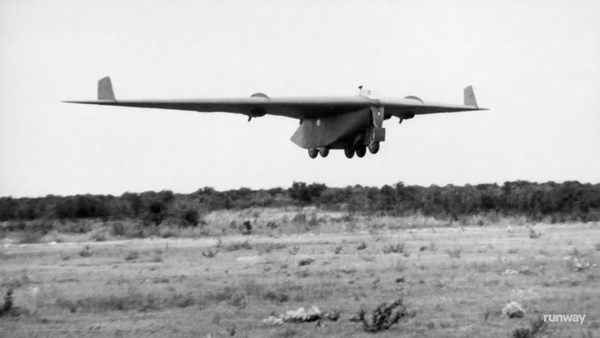
This article was originally published in October 2003 here at the LAAHS Website.
In Memoriam
We are republishing this article to pay homage to its author, Hernán Longoni, who passed away on January 21, 2025. Throughout his years as a dedicated member of our community, Hernán enriched our collective knowledge through his meticulous research and thoughtful contributions to the LAAHS website, particularly in documenting Argentina’s rich aviation heritage. His passion for preserving aviation history and willingness to share his expertise made him an invaluable member of our Society. His legacy will continue to inspire future generations of aviation historians.

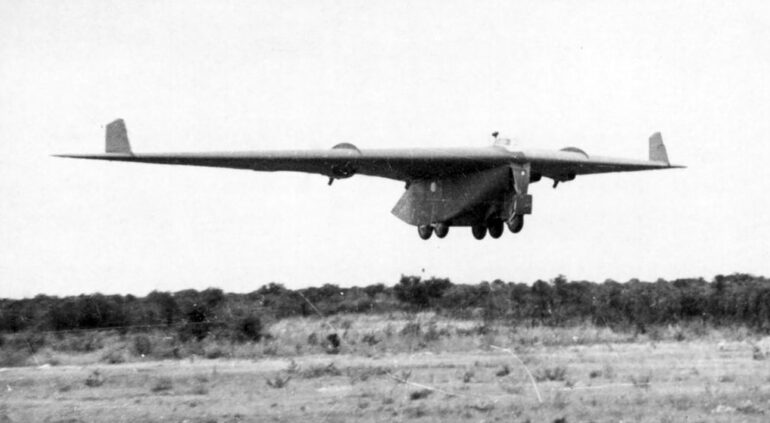





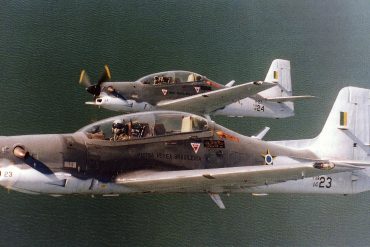
I personally knew Hernan, the author of this article.
There is a mistake in it, in fact the IAe-38 was never called “Naranjero”. This name was mentioned for the first time in the book “Las Alas de Perón”, an invention of the author Ricardo Burzaco, whom I also know personally.